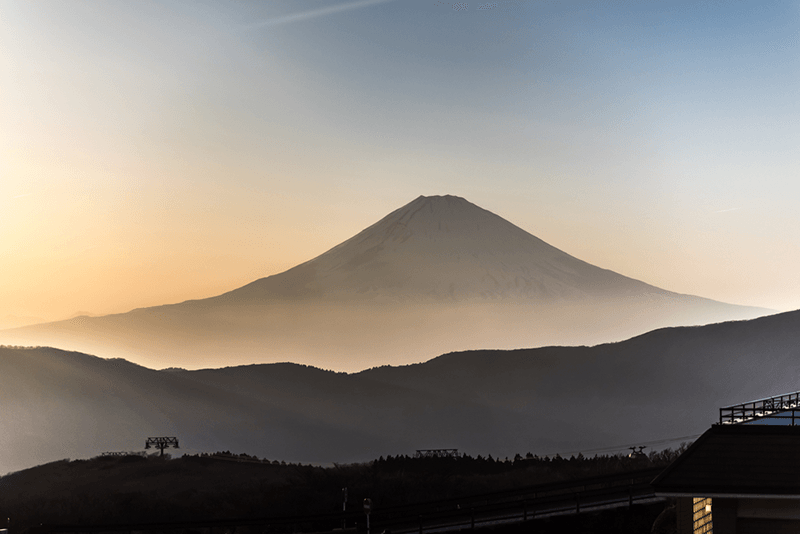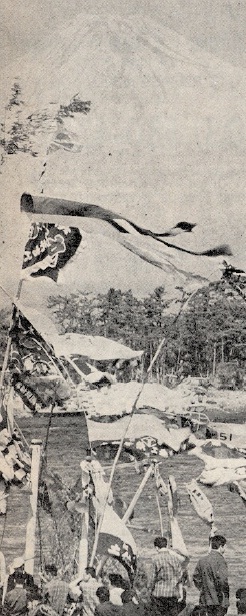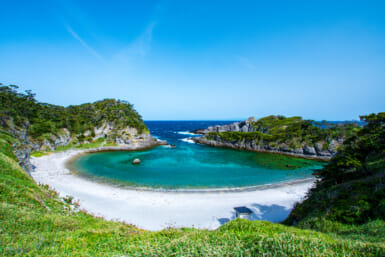by W. Somerset Watanabe
Since the season for this particular form of madness opens on Tuesday, July the first, we feel it not inappropriate to toss in at this time a few thoughts on the relative merits of climbing (hmm!) or not climbing (aah!) that most majestic and most magic of all mountains – Fuji-san!
For two solid months – from July the first until the end of August – the slopes of Mount Fuji are black – or actually a kind of dirty white, as we shall see – with swarming lines of Japanese pilgrims and restless foreigners who struggle on and up through the soft and shifting volcanic ash.
Why? you may well ask. Why bother? Well, at first glance, the classic answer would appear to be the best answer – “Because it is there!” and no one, but no one, can deny that Mount Fuji is unavoidably there. Because it is there, however, is not the most cogent reason for the vast majority of climbers to tackle its exhausting slopes.
For the Japanese, the ascent of Mount Fuji is a solemn and sacred pilgrimage that goes back for many centuries. An account of one pilgrim’s experience, for example, written almost five hundred years ago, states that the lines of people toiling up the sides of Fuji even in those days were “endless.”‘ Apparently little has changed since that time.
Around the middle of the sixteenth century an enterprising young man named Kakugyo formed a religious organization known as Fujiko, with Mount Fuji being the inspiration and focal point of his faith. Kakugyo declared that Mount Fuji was “the beginning of heaven and earth, the pillar of the nation and the foundation of the national welfare.”
Well sir, that pretty well covered the ground and thousands of people flocked to worship in this new faith. According to the record, the good Mr. Kakugyo lived to the ripe old age of a hundred and five, at which time, faithful to the last, he passed away quietly in a small cave high on the slopes of his beloved mountain.
The Fujiko movement steadily increased in popularity even after Kakugyo’s death, and it is estimated that there were over eight hundred active branches during the latter part of the Tokugawa era, a period which ran from 1603 until 1867.
Since many elderly people were physically unable to actually climb Mount Fuji – and since it was not until 1800 that women were even permitted to climb the sacred mountain – miniature Mount Fujis were erected in shrines and temples throughout the land to enable the lame, the halt, the blind – and the women – to make their pilgrimage by proxy as it were. This practice tended to negate the original intent of the Fujiko movement, however, and other groups, operating under other names, were quick to take advantage of the situation and Fujiko was gradually pushed into the background until it finally remained only for those who actually made the climb.
Today, each Fujiko group has a leader – called a Komoto – as well as a group of men who act as guides – called Sendatsu – and the rank and file of the membership are in turn called Koju. The principle article of faith involves an annual climb of the sacred mountain but the followers of Fujiko pay daily homage to Sengen Daibosatsu, the spirit of Mount Fuji, and they follow Sengen Daibosatsu’s spiritual guidance in the conduct of their family and business lives from day to day.
For the actual climb, devout Japanese pilgrims always wear a loose white costume (which signifies purity of heart) and this costume is never subjected to the indignity of being washed. As the years roll by it tends to become dirtier and dirtier and it also acquires more and more of the distinctive red seals that are stamped on ceremoniously with each ascent. The dirtiness of the costume and the number of red seals – the more the better are matters of great pride to the pilgrim as they label him as a veteran climber and, of course, a true worshiper in the Fujiko faith.
To watch a group of these devout pilgrims as they struggle up the slopes of Mount Fuji with their traditional long staffs in hand and to hear them chanting their prayers over and over as they slowly but steadily climb higher and higher is an unusually moving and unforgettable experience.
This then brings us to the foreigner’s dilemma — to climb or not to climb? An old Japanese saying claims that a man is a fool if he never climbs Mount Fuji, but it then goes on to say that he is even a bigger fool if he climbs it more than once! We think this sums up the whole problem rather neatly and we will leave the decision in your good hands.
The easiest route to Fuji by train is the one daily express from Shinjuku to Kawaguchiko (better call and check the time). If you miss the express, catch the train to Otsuki and then the Fuji Electric Railway to Kawaguchiko.
The trip is about ¥530, one way. From tiny Kawaguchiko, take the No. 7 bus from the station adjoining the train platform. The bus ride is about an hour at the end of which you’ll board another bus which rattles its way to the 7,342-foot-high fifth station, the embarkation point for all but the hardcore climbers. The entire trip from Shinjuku takes four to five hours.*
And by the way, for your information Mount Fuji is exactly a year high. As everyone knows, there are 12 months in a year as well as 365 days, and the official height of Mount Fuji is, believe it or not, 12,365 feet even during leap year – and the view from the top is terrific!
[*Fortunately, the trip to Mt. Fuji has gotten to be easier and faster since this story was published 41 years ago. A few links with travel information can be found below.]
www.jnto.go.jp/eng/pdf/transportation/Shinjuku_Kawaguchiko_schedule.pdf (PDF of the train service schedule between Shinjuku and Kawaguchiko)










